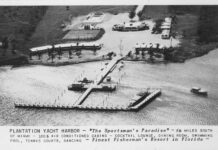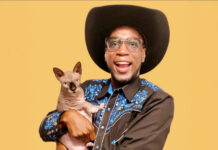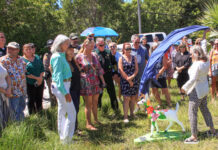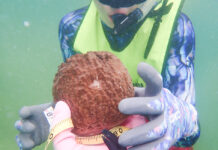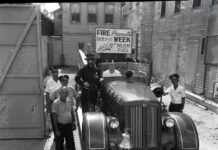I’ll warn you: I’m having a Papa’s Pilar Blonde at 1:53 p.m. on a work day in order to conjure the words necessary to write about Hemingway, here on the cusp of Hemingway Days. Worse yet, to delve into Hemingway’s relationship with women, in only 500 words. It’s only right to write Hemingway short, one might say (His most famous short story is perhaps “For sale: baby shoes, never worn”).
One might also say it’s only appropriate to drink while writing about Hemingway. But that supports a dogged myth: that Hem was a drunk writer. Hemingway woke early, around 5 a.m., and wrote from 6 a.m. to noon. In Key West, he wrote from the perch of his study over the pool — Pauline’s pool, he might argue — and often stood, with a high desk for his typewriter. He was focused, resolute in his writing. He didn’t start drinking until lunchtime, when he’d completed his work for the day.
Hemingway wrote to Esquire editor Arnold Gingrich in 1935 (during his tenure in Key West): “When you work hard all day with your head and know you must work again the next day, what else can change your ideas and make them run on a different plane like whisky?” So while perhaps while Hemingway was a drunk and a writer, he was not in fact a drunk writer.
In the same vein, I posit that while Hemingway could be hateful and kept company with many (fascinating, fearsome, complex) women, he wasn’t a hater of women, an accusation often leveled at him. The real exception is his mother. Third wife, journalist Martha Gelhorn, wrote wisely: “I know enough to know that no woman should ever marry a man who hated his mother.” Yet, the young Hemingway and his mother are said to have blamed each other for his father’s suicide, an end to which he, too, would succumb. Thus, his barbed comments are tinged, at least for this reader, with real tenderness, rejection and heartbreak.
I summarize Hemingway’s female-driven anger clumsily, and perhaps apologetically — blame it on the Pilar — as Hemingway could in fact be a real jerk. Wife followed wife, with notable overlap (he left Hadley in Paris, Pauline in Key West, Mary in Idaho, and thank God Martha left him) and by following his father’s path in taking his own life, he left them — and us — entirely.
In the era of the #metoo movement, in a time when powerful, wealthy white men are being held accountable as never before, how does Hemingway’s legacy endure with the modern woman? If we consider his body of work in blunt relief, it is a catalog of masculinity: guns and game hunting (“The Short Happy Life of Francis Macomber,” “The Green Hills of Africa”), fishing and rum-running (“The Old Man and the Sea,” “To Have and Have Not”), bullfighting and drinking (“The Sun Also Rises” and well, everything else), war and women (“For Whom the Bell Tolls,” “A Farewell to Arms”). But that robs his legacy, and him, of all nuance, and worse, of all tenderness evidenced in his pages. In “Men Without Women,” he wrote: “The most painful thing is losing yourself in the process of loving someone too much, and forgetting that you are special too.”
Hemingway seemed to write often in defense of his, or his male characters’, “specialness” or worthiness, and “Men Without Women” evidences that. Critics, readers and voyeurs have also speculated about Hemingway’s sexuality. In my opinion, one of his best female characters, Lady Brett Ashley, was nearly a man in drag, her physical and psychological characteristics (hard drinking, broad-shouldered, short-haired, roughly sexual, callous) could broadly and historically be described as “masculine.” In an unpublished manuscript of his, called “Garden of Eden,” he narrates a couple switching gender roles with liberation, indicating a much more fluid relationship with sexuality. Which might explain quite a lot.
His friction with women, and his habit of cycling through them, might be explained by a few more contextual clues. His mother Grace was a tough suffragette who married a man, Dr. Clarence Hemingway, who took his own life. Hemingway followed that pattern nearly like a tame horse following a trail. He was attracted to (and alternately repulsed by) older, strong(er) women, falling in love with nurse Agnes Von Kurowsky in World War I, who was seven years his senior, and who left him for an Italian military officer (and worth noting, then came to be a librarian in Key West). He had fiery documented arguments with the aforementioned Martha Gelhorn, a war correspondent, and Pauline Pfieffer, also a journalist.
When Hemingway moved to Key West with Pauline, a beauty and a business owner of independent means, he enlisted the help of Toby Bruce, his “Man Friday,” and Bruce’s sharply intelligent Conch wife Betty. She was a Curry, a genealogist, and by all accounts, a force to be reckoned with. In the letters between Hemingway and Betty Bruce, which I had the privilege of reading with the help of Bruce’s son, who still lives in Key West, I got a peek into what Hemingway looked like as “buddies” with a woman. In a letter responding to hers (which I never saw), it’s clear Bruce was apologizing for her behavior. Hem writes:
“You weren’t bitchy, or if you were, it was perfectly allowable … I’ve been around women all my life, and if a good woman isn’t a little bit bitchy, sometimes it’s as though she hasn’t any taste.”
Perhaps, much like the great marlins, sharks, water buffalo, lions and bulls about which Hemingway writes, he loved and admired women he couldn’t control. If he wrote with ire, it was the ire of the love unrequited, the creature untamed. And how better to lionize, rather than sexualize, such creatures than in art?
As we approach the anniversary of Hem’s birthday, I find myself wanting to write about Hemingway as a Cancer (notoriously melancholy and mercurial), and Hemingway as a lover (seemingly platonic with several wives), and Hemingway as a tortured victim of toxic masculinity (his penis envy, his death), and Hemingway hiding behind a beard. I could write a book on him, but I can’t, because I’m well over word count already.
But breaking the rules is something Hemingway might like in a woman like me.

